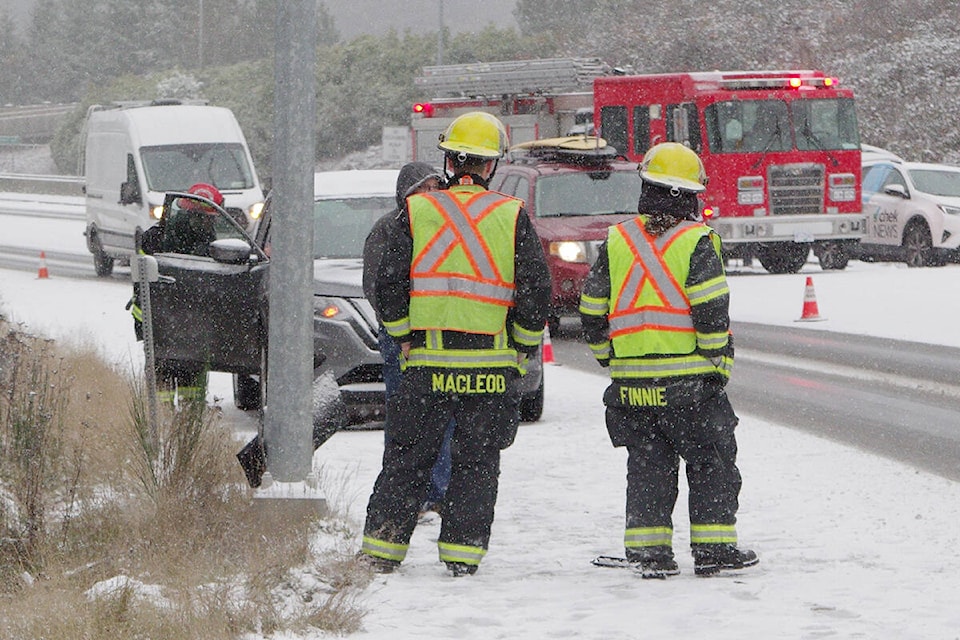CORRECTION: A previous version of this article provided an incorrect figure for the number of firefighters that would be hired as part of a recommended fire master plan. The News Bulletin regrets the error and any inconvenience it may have caused.
Anyone in Nanaimo who’s dreamed of becoming a firefighter might want to update their resumé.
City councillors, at a special finance and audit committee meeting Thursday, Dec. 1, unanimously recommended hiring 40 additional firefighters and purchasing two fire trucks to meet a steep rise in demand for Nanaimo Fire Rescue’s services.
Nanaimo’s firefighters took up much of the seating in the Shaw Auditorium to hear fire chief Tim Doyle present a request for additional firefighters and equipment as councillors discussed the 2023-27 financial plan.
“Clearly, the reason why we’re here today and why these business cases are here before you is the urgent need for firefighters in the City of Nanaimo that was identified in the fire master plan,” Doyle said. “I think that’s demonstrated by the membership showing up and how committed and passionate they are about serving the community and … about their own firefighter safety.”
He said there has been a “fundamental shift” in the demand for fire services that consultants could not have foreseen when data was compiled in 2017-2019, and the rising demand on Nanaimo Fire Rescue in 2022 “has simply been staggering.” Nanaimo Fire Rescue is on track to exceed 9,600 responses to incidents this year, an increase of about 30 per cent over 2021.
Firefighters are now responding, on average, to 27 incidents per day.
“In the last two months we’ve responded to over 50 days of over 27 [incidents a day],” Doyle said.
Normally NFR is busier in the summer and on weekends, and demands for service tapers off outside of those peak demand periods, but that is no longer the case.
“We’re not seeing a tailing off of incidents. We’re actually seeing a ramping up,” the fire chief said. “In fact, we responded to 31 incidents a couple days ago and we responded to 40 incidents yesterday. In fact, based on our data from 2017-19, the consultants expected us to reach this level of response somewhere between 2030 and 2035. What’s even more alarming, if we expect the same level of year-over-year increase in 2023, NFR will exceed 12,000 incidents at the end of next year, which we were projected to reach two decades from now.”
Doyle said the demand is stretching resources, which has to be addressed, and he also reminded the finance committee that the fire master plan from 2005 was never fully completed, which is also contributing to “our urgent need right now.”
He cited a media report about a fire station in Vancouver’s downtown east side that ranked it as the busiest in B.C. and possibly all of Canada.
“While they may be the busiest in terms of the number of incidents they get there … our firefighters at Station 1 will respond to more incidents per firefighter than their busiest station in B.C., because we have four personnel at that station, while they have 14 personnel at [their] station.”
Those levels of work, stress and accumulated trauma impact firefighters’ mental and emotional resilience. Doyle cited figures from B.C. Municipal Safety Association, which tallied $70 million paid out in the first half of 2022, $28 million related to mental health. He also mentioned that 60 per cent of the time, the fire department is at bare minimum staffing because of leave, injuries, mental health and other reasons.
The committee voted unanimously to recommend budgeting for the hiring of 40 new firefighters – 20 in 2023 and 20 in 2025 – and to purchase a heavy rescue vehicle with water pumping capabilities for Station No. 1 and a new front-line engine for Station No. 2 to enter service in 2025. Cost for the fire trucks, modifications and renovations to fire stations to accommodate the vehicles is $4.3 million. The fire master plan implementation was proposed to add 0.44 per cent to property taxes in 2023 and 1.21 per cent in 2024.
Mayor Leonard Krog said the cost will present a challenge for the budgeting process and for taxpayers, but called it “a completely appropriate investment.”
“I think most of us … understand the tremendous pressure and the impact of the continual work that is done in sometimes awful and horrible situations, which most of humanity, mercifully doesn’t have to endure,” he said. “When you go to work in a safe workplace and you come home and you haven’t had to deal with someone who’s injured or someone who’s passed or people under stress, you really live a wonderfully innocent life. That is not true of those who choose this profession or the people you work for.”
Members of the public can offer their views of the city’s draft financial plan at an e-town hall meeting Monday, Dec. 5, at 7 p.m. at the Vancouver Island Conference Centre. For more information, visit www.nanaimo.ca.
READ ALSO: Nanaimo city council begins budgeting process with potential 6.2% property tax increase
chris.bush@nanaimobulletin.com
Like us on Facebook and follow us on Twitter
